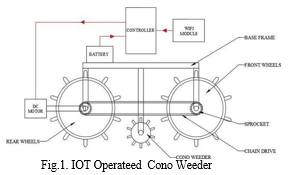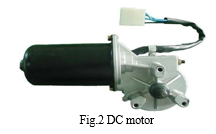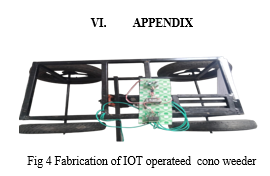Ijraset Journal For Research in Applied Science and Engineering Technology
- Home / Ijraset
- On This Page
- Abstract
- Introduction
- Conclusion
- References
- Copyright
Design and Fabrication of IoT Operated Cono Weeder
Authors: Sathees T, Prakash K, Praveen J, Ranjith Kumar S, Siva Guru Nathan C
DOI Link: https://doi.org/10.22214/ijraset.2023.50687
Certificate: View Certificate
Abstract
In this modern era research in the agricultural fields going on. Day by day the population of India is increasing and to fulfill the need of food, modernization of agricultural sectors is important. Mechanization gives higher productivity in minimum input. Farmers are using same traditional methods. Paddy is one of the major crops grown in India. The problems in paddy cultivation are availability of labours, low productivity rate and more manual The problems in paddy cultivation are availability of labors, low productivity rate and more manual efforts required for weeding. For paddy cultivation, more time is required because of fertilizer feeding and weeding processes. For reducing these problems design and fabrication of auto functioned weeder is madeas our concept. This machine is designed as per the standard dimensions which suits for the field and then fabrication process is carried. The weeder will remove weeds between two rows. It will remove multiple weeds in less time, so a complex operation is completed in a simple and effective manner. Therefore, it reduces the manpower, labour costandalso time.
Introduction
I. INTRODUCTION
A. Cono Weeder
India is agriculture-based country. Our economy also depends on agricultural products. Nowadays tremendous changes have occurred in conventional methods of agriculture like seed plantation, irrigation system, pesticides and spray used. For developing our Economic condition, it is necessary to increase our agricultural productivity and quality. Majority of the Indian population depends on agriculture and agro-based industries andbusinesses. In Indian agriculture paddy cultivation is one of the main commercial crop. Rice isone of the chief grains of India. Rice is the basic food crop and being a tropical plant, it flourishes comfortably in hot and humid climate. Rice is mainly grown in rain fed areas that receive heavy annual rainfall. Rice is the staple food of eastern and southern parts of India. Rice can be cultivated by different methods based on the type of region. Rice grows on a variety of soils like silts, loams and gravels. It can also tolerate alkaline as well as acid soils. However, clayey loam is well suited to the raising of this crop. Actually, the clayey soil can be easily converted into mud in which rice seedlings canbe transplanted easily. Proper care has to be taken as this crop thrives if the soil remains wet and is under water during its growing years. Rice fields should be level and should have low mud walls for retaining water. In the plain areas, excess rainwater is allowed to inundate the rice fieldsand flow slowly. Rice raised in the well-watered lowland areas is known as lowland or wet rice. In the hilly areas, slopes are cut into terraces for the cultivation of rice. Thus, the rice grown in the hilly areas is known as dry or upland rice. Interestingly, per hectare yield of upland rice is comparatively less than that of the wet rice.

The weeds have always been problems in the cultivation of crops as they lower the yield and quality. Weeds also may directly reduce profits by hinderingharvest operations and producing chemicals that are haremful to crop plants.
II. LITERATURE REVIEW
Snehal Vidyasagar Shamkuwar Swanker RAGHUNANDAN Swarnkar Pankaj Gupta Vinay Kumar Budhe (2019), Weed is a major problem in crop production, affecting the crop yield as well as the quality of harvested produce. Weeds compete with the main crop for soil nutrients (NPK) of worth Rs 5,000 crores per year in India. The value of total crop losses due to weeds is around Rs. 10,000 crores (Rao, 2000). Weed control is one of the most difficult tasks in crop production agriculture that accounts for a considerable share of the cost involvedin agricultural production. There are many methods for weed management, but out of those methods, chemical methods are the most popular. These methods are hazardous for the environment as well for as for human health. To ensure food security and sustainable development of agriculture, it is critically important to develop chemical and pollution- free agricultural products. This study has been carried out to know the different weed controlling techniques used by the different researchers to be adapted in agricultural work
Development and Evaluation of Self- Propelled Cono Weeder for Rice Cultivation in Vertisol (2019), Weeding is one of the important agricultural operation. 30 to 60 per cent of crop yield is affected due to improper weeding. Intercultural/weeding operation in paddy crop is very important operation where the worker in bending position used to uproot the weeds that might affect their health therefore it is quite necessary to have suitable agricultural implements which farmers can use and also allow them to use for custom hiring. A self propelled cono weeder was developed and tested ergonomically and mechsnicslly. The frame of the developed self- propelled cono weeder was fabricated from hollow square pipe of having a thickness of 2 mm. The support of drive wheel of weeder was fabricated from mildsteel 8mm. The travel speed, weeding efficiency, fiels capacity and fuel consumption on deceloped powered cono weeder.
PushprajDjwan,RKnalk,Suryaka ntSonwani,ShubhamSinhaandYogesh kumar Kosariys Developing situation of mechanicasl weeding in rice(2019). Maximum operations in paddy cultivation are now mechanized. Mechanization continuous improved the effectiveness of work and reduced the problem of labours Maximum operations in paddy cultivation are now mechanized. Mechanization continuously improved the effectiveness of work and reduced the problem of labour shortage and also the cost of cultivation. After system of line sowing of paddy field mechanization continuously improved in weeding. This found more desirable than the manual hand picking and chemical weeding methods. Mechanical weeding done by manual weeder, animal drawn weeder and power operated weeder. Power weeders perform better than the manual and animaldrawn weeders in case of reduce the cost and labour problem. Mechanical weeder and their improvement are discussed in this paper.
Suryakanta Khandai , Ashok Tripathi , Virendra Kumar , Ashish Kumar Kerketta and Surendra , “Modification of Existing Power Weeder and Study on the Cost Economics of DifferentWeeding Methods”(2019), Weeding is a time consuming and tedious operation in rice farming system. So years a go a lot efforts are made to design different types of weeder like manual, animal drawn, self- powered or tractor operated. The existing STIHL power weeder is self-powered, low weight, tomarrow type, have features like 1.8 hp, 2-stroke petrol engine. Modified version has float with centrally driven worm gear system for power transmission. The minimum row to row distance should be 25 cm with line sowing/transplanting for better operation of weeder. One extra covering attachment is given to protect the splashing of mud into the operator surface. Alternate peg systemin weeding wheel is provided for weeding in row. Modified weeder took less time (2 hours) to cover one-acre area. The cost incurred to cover one-acre area for modified weeder isINR 500 in comparison to existing weeder is INR 750.
III. METAL FRAME MANUFACTURING PROCESS
The metal frame is generally made of mild steel bars for machining, suitable for lightly stressed components including studs, bolts, gears and shafts. It can be case-hardened to improve wear resistance. They are available in bright rounds, squares and flats, and hot rolled rounds. Suitable machining allowances should therefore be added when ordering. It does not contain any additions for enhancing mechanical or machining properties. Bright drawn mild steel is an improved quality material, free of scale, and has been cold worked (drawn or rolled) to size. It is produced to close dimensional tolerances. Straightness and flatness are better than black steel. It is more suitable for repetition precision machining. Bright drawn steel has more consistent hardness, and increased tensile strength. Bright steel can also be obtained in precision turned or ground form if desired.
A. Manufacturing Process
Manufacturing processes are the steps through which raw materials are transformed into afinal product. The manufacturing process begins with the creation of the materials from which thedesign is made. These materials are then modified through manufacturing processes to become the required part. Manufacturing processes can include treating (such as heat treating or coating), machining, or reshaping the material. The manufacturing process also includes tests and checks for quality assurance during or after the manufacturing, and planning the production process priorto manufacturing.
IV. COMPONENTS AND EXPLANATION
A. DC Motor
A DC motor is any of a class of rotary electrical machines that converts direct current electrical energy into mechanical energy. The most common types rely ontheforces produced by magnetic fields. Nearly all types of DC motors have some internal mechanism, either electromechanical or electronic; to periodically change the direction of currentflow in part of the motor. Different number of stator and armature fields as well as how they are connected provides different inherent speed/torque regulation characteristics teristics. The speed of a DC motor can be controlled by changing the voltage applied to the armature. The introduction of variable resistance in the armature circuit or field circuit allowed speed control. Modern DC motorsare often controlled by power electronics systems which adjust the voltage by "chopping" the DC current into on and off cycles which have an effective lower voltage.

B. Battery
A battery is a device that converts chemical energy directly to electrical energy. It consists of a number of voltaic cells; each voltaic cell consists of two half cells connected in series by a conductive electrolyte containing anions and cations. One halfcell includes electrolyte and the electrode to which anions migrate, i.e., the anode or negative electrode; the other half-cell includes electrolyte and the electrode to which cations migrate, i.e., the cathode or positive electrode. In the redox reaction that powers the battery, reduction occurs to cations at thecathode, while oxidation occurs to anions at the anode.

C. Sheet Metal
Sheet metal is metal formed by an industrial process into thin, flat pieces. It is one of the fundamental forms used in metalworking and it can be cut and bent into a variety of shapes. Countless everyday objects are fabricated from sheet metal.
Thickness can vary significantly extremely thin thickness are considered foil or leaf, and pieces thicker than 6 mm are considered plate. Sheet metal is available in flat pieces or coild strips.
D. Relay
A relay is an electrically operated switch. Many relays use an electromagnet to mechanically operate a switch, but other operating principles are also used, such as solid-state relays. Relays are used where it is necessary to control a circuit by a low- power signal (with complete electrical isolation between control and controlled circuits), or where A relay is an electrically operated switch. Many relays use an electromagnet to mechanically operate a switch, but other operating principles are also used, such as solid-state relays. Relays are used where it is necessary to control a circuit by a low-power signal (with complete electrical isolation between control and controlled circuits), or where several circuits must be controlled by one signal. The first relays were used in long distance telegraph circuits as amplifiers: they repeated the signal coming in from one circuit and re-transmitted it on another circuit. Relays were used extensively in telephone exchanges and early computers to perform logical operations.
V. APPLICATIONS
Relays are used wherever it is necessary to control a high power or high voltage circuit with a low power circuit. The first application of relays was in long telegraph systems, where the weak signal received at an intermediate station could control a contact, regenerating the signal forfurther transmission. High-voltage or high-current devices can be controlled with small, low voltage wiring and pilots switches. Operators can be isolated from the high voltage circuit. Low power devices such as microprocessorscan drive relays to control electrical loads beyond their direct drive capability. In an automobile, a starter relay allows the high current of the cranking motor to be controlled with small wiring and contacts in the ignition key.
Electromechanical switching systems including Strowger and Crossbar telephone exchanges made extensive use of relays in ancillary control circuits. The relay Automatic Telephone Company also manufactured telephone based solely on relay switching techniques designed by Gotthilf Ansgarius Betulander.
A. IOT
The Internet of things (IoT) is a system of interrelated computing devices, mechanical and digital machines are provided with unique identifiers (UIDs) and the ability to transfer data over a network without requiring human-to- human or human-to-computer interaction.The definition of the Internet of things has evolved due to the convergence of multiple technologies, real-time analytics, machine learning, commodity sensors, and embedded systems.[1] Traditional fields of embedded systems, wireless sensor networks,control systems, automation (including home and building automation), and others all contribute to enabling the Internet of things. In the consumer market, IoT technology is most synonymous with products pertaining to the concept of the "smart home", covering devices and appliances (such as lighting fixtures, thermostats, home security systems and cameras home appliances) that support one or more common ecosystems, and can be controlled via devices associated with that ecosystem, such as smartphones and smart speakers.
B. Sprocket
Chain drive is a way of transmitting mechanical power from one place to another. It isoften used to convey power to the wheels of a vehicle, particularly bicycles and motorcycles.It is also used in a wide variety of machines besides vehicles. Most often, the power is conveyed by a roller chain, known as the drive chain or transmission chain, passing over a sprocket gear, with the teeth of the gear meshing withthe holes in the links of the chain. The gear is turned, and this pulls the chain putting mechanical force into the
system.
???????C. Shaft
Shaft diameter: 12mm Material: mild steel Length:26 inch.Shaft is a common and important machine element. It is a rotating member, in general, has a circular cross- section and is used to transmit power. The shaft may be hollow or solid. The shaft is supported on bearings and it rotates a set of gears or pulleys for the purpose of power transmission Design of shaft primarily involves in determining stresses at critical point in the shaft that is arising due to aforementioned loading. Other two similar forms of a shaft are axleand spindle.
???????D. Metal Strip
Metal strip is narrow, thin stock that is usually 3/16 in. (4.76 mm) or less in thickness and under24 in. (609.6 mm) in width. Metal strips are formed to precise thicknesses and/or width requirements.
 ???????
???????
Conclusion
Operating with the Self-propelled cono weeder had a heart rate of 116.89 beats and oxygen consumption rate of 0.649 l/min. The energy expenditure rate was also obtained as13.54 kJ/min. The field capacity and field efficiency was found to be 0.032 ha/h and 94.49% with weeding efficiency of 68.77%. The minimum man hour required for controlling the weedwith self- propelled cono weeder is 25 man-h/ha at the operating speed of 2.28 km/h with fuelconsumption of 6.77 l/ha. The developed machine is efficient in operation, but there is little instability as the power source is mounted on one side. This can be avoided if we mounted thepower source above the ground wheel. we have bought the required materials for designing of iot operated cono weeder. The components and study about the iot operated. This project is a main purpose of the formers to remove the weeds around the paddy to reduce labor cost and time. In phase II to analyses and testing of Internet of Things (IOT). And using DC motor to work Faster to reduce time. And manually operated.
References
[1] Snehal Vidyasagar ShamKuwar RAGHUNANDAN Swarnkar Pankaj Gupta Vinay KumarBudhe. [2] Bishorjit Ningthoujam. Atul Kumar Shrivastava Development and evaluation of self- Propeeled Cono weeder for rice Cultivation in Vertisol. [3] Pushpraj Diwan, RK Naik, Suryakant Sonwani, Shubham Sinha and Yogesh KumarKosariya. [4] Suryakanta Khandai, Ashok Tripathi Virendra Kumar, Ashish Kumar Kerketta andSurendra Pa. Ayyadurai P. and R. Thiyagarajan. [5] Biswas HS, Ojha TP, Ingle GS. Development of animal drawn weeders in India.Agricultural Mechanization in Asia, Africa & Latin America. 2020; 30(4):57- 62. [6] Deshmukh G, Tiwari RK. Impact of weeders for weed management in systems of rice intensification (SRI). Indian J. Weed Sci. 2020; 43(3&4):243- 244.Din M, Mehta CR, Annamalia SJK, Singh M, Behera D, Pailkray
Copyright
Copyright © 2023 Sathees T, Prakash K, Praveen J, Ranjith Kumar S, Siva Guru Nathan C. This is an open access article distributed under the Creative Commons Attribution License, which permits unrestricted use, distribution, and reproduction in any medium, provided the original work is properly cited.

Download Paper
Paper Id : IJRASET50687
Publish Date : 2023-04-20
ISSN : 2321-9653
Publisher Name : IJRASET
DOI Link : Click Here
 Submit Paper Online
Submit Paper Online

